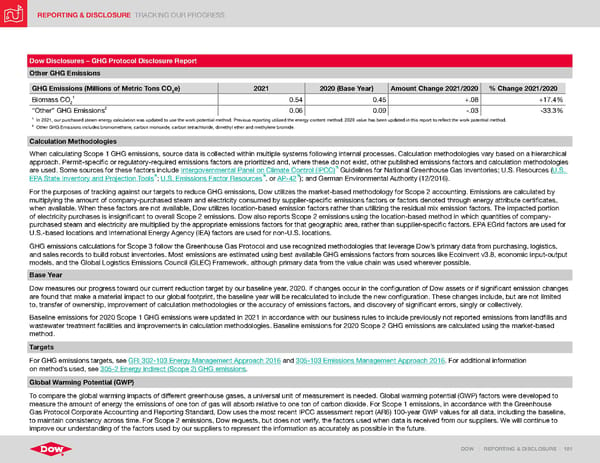REPORTING & DISCLOSURE TRACKING OUR PROGRESS DOW | REPORTING & DISCLOSURE | 181 Dow Disclosures – GHG Protocol Disclosure Report Other GHG Emissions GHG Emissions (Millions of Metric Tons CO 2 e) 2021 2020 (Base Year) Amount Change 2021/2020 % Change 2021/2020 Biomass CO 2 1 0.54 0.45 +.08 +17.4% “Other” GHG Emissions 2 0.06 0.09 -.03 -33.3% 1 In 2021, our purchased steam energy calculation was updated to use the work potential method. Previous reporting utilized the energy content method. 2020 value has been updated in this report to reflect the work potential method. 2 Other GHG Emissions includes bromomethane, carbon monoxide, carbon tetrachloride, dimethyl ether and methylene bromide. Calculation Methodologies When calculating Scope 1 GHG emissions, source data is collected within multiple systems following internal processes. Calculation methodologies vary based on a hierarchical approach. Permit-specific or regulatory-required emissions factors are prioritized and, where these do not exist, other published emissions factors and calculation methodologies are used. Some sources for these factors include Intergovernmental Panel on Climate Control (IPCC) Guidelines for National Greenhouse Gas Inventories; U.S. Resources ( U.S. EPA State Inventory and Projection Tools ; U.S. Emissions Factor Resources , or AP-42 ); and German Environmental Authority (12/2016). For the purposes of tracking against our targets to reduce GHG emissions, Dow utilizes the market-based methodology for Scope 2 accounting. Emissions are calculated by multiplying the amount of company-purchased steam and electricity consumed by supplier-specific emissions factors or factors denoted through energy attribute certificates, when available. When these factors are not available, Dow utilizes location-based emission factors rather than utilizing the residual mix emission factors. The impacted portion of electricity purchases is insignificant to overall Scope 2 emissions. Dow also reports Scope 2 emissions using the location-based method in which quantities of company- purchased steam and electricity are multiplied by the appropriate emissions factors for that geographic area, rather than supplier-specific factors. EPA EGrid factors are used for U.S.-based locations and International Energy Agency (IEA) factors are used for non-U.S. locations. GHG emissions calculations for Scope 3 follow the Greenhouse Gas Protocol and use recognized methodologies that leverage Dow’s primary data from purchasing, logistics, and sales records to build robust inventories. Most emissions are estimated using best available GHG emissions factors from sources like Ecoinvent v3.8, economic input-output models, and the Global Logistics Emissions Council (GLEC) Framework, although primary data from the value chain was used wherever possible. Base Year Dow measures our progress toward our current reduction target by our baseline year, 2020. If changes occur in the configuration of Dow assets or if significant emission changes are found that make a material impact to our global footprint, the baseline year will be recalculated to include the new configuration. These changes include, but are not limited to, transfer of ownership, improvement of calculation methodologies or the accuracy of emissions factors, and discovery of significant errors, singly or collectively. Baseline emissions for 2020 Scope 1 GHG emissions were updated in 2021 in accordance with our business rules to include previously not reported emissions from landfills and wastewater treatment facilities and improvements in calculation methodologies. Baseline emissions for 2020 Scope 2 GHG emissions are calculated using the market-based method. Targets For GHG emissions targets, see GRI 302-103 Energy Management Approach 2016 and 305-103 Emissions Management Approach 2016 . For additional information on method’s used, see 305-2 Energy indirect (Scope 2) GHG emissions . Global Warming Potential (GWP) To compare the global warming impacts of different greenhouse gases, a universal unit of measurement is needed. Global warming potential (GWP) factors were developed to measure the amount of energy the emissions of one ton of gas will absorb relative to one ton of carbon dioxide. For Scope 1 emissions, in accordance with the Greenhouse Gas Protocol Corporate Accounting and Reporting Standard, Dow uses the most recent IPCC assessment report (AR6) 100-year GWP values for all data, including the baseline, to maintain consistency across time. For Scope 2 emissions, Dow requests, but does not verify, the factors used when data is received from our suppliers. We will continue to improve our understanding of the factors used by our suppliers to represent the information as accurately as possible in the future.
 ESG Report | Dow Page 180 Page 182
ESG Report | Dow Page 180 Page 182